Mouthparts of insects are modified cephalic appendages. Different insects have adapted themselves to different modes of ingestion of food. The basic structure of mouthparts remains the same. These similar mouthparts are an example of homologous organs. Homometabolous insects have different types of mouthparts in their larvae and adult stages. Hemimetabolous insects have similar type of mouthparts in their larvae and adult stages.
The mouthparts of butterfly and moths are siphoning and sucking type. These mouthparts are best suited to draw nectar from the flowers. Siphoning-sucking mouthparts are mostly limited to adult butterflies and moths (Order Lepidoptera). Immature moths and butterflies have chewing mouthparts. The following are the features of the siphoning and sucking mouthparts,
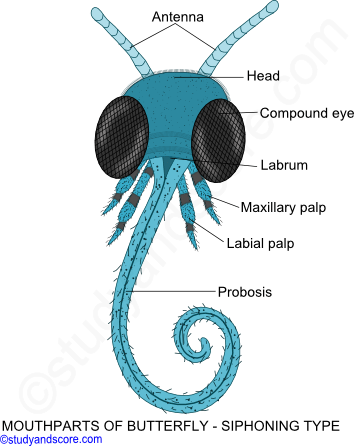
Insects with siphoning-sucking mouthparts do not chew their food, but have a siphon-like structure that allows them to suck or siphon liquid into their body. This feeding is analogous to inserting a straw into a drink to withdraw liquid. At the time of feeding, the proboscis which is coiled like a watch spring is straightened up due to high pressure of haemolymph. This pressure is generated in the stipes which is associated with each galea. Coiling results from the elasticity of the cuticle of galea together with the activity of the intrinsic muscles. The uncoiled-proboscis thrusts out into the nectaries of the flower. Due to the sucking action of cibarium muscles and pharyngeal muscles, the nectar is sucked up.
Mouthparts of insects are modified cephalic appendages. Different insects have adapted themselves to different modes of ingestion of food. The basic structure of mouthparts remains the same. These similar mouthparts are an example of homologous organs. Homometabolous insects have different types of mouthparts in their larvae and adults. Hemimetabolous insects have similar type of mouthparts in their larvae and adults.
The mouthparts of cockroach are biting and chewing type. This biting and chewing type of mouthparts are considered as the most primitive and unspecialized of all the mouthpart types. The other examples include grasshopper, dragonfly and beetle. Also the larvae of mosquito, housefly butterfly and honeybee also have biting and chewing mouthparts.
The mouthparts of cockroach are developed to suit its habit of feeding on solid food and as a result it has well developed mandibles. All the components of the mouthparts are present without any modification. These mouthparts help the cockroach to bite and chew on hard stuffs, consume soft stuffs and also lap upon liquids. The mouthparts also include Labrum, Mandibles, and a pair of first maxillae, labium, and hypopharynx. The following is the structure of each of the mouthpart,
Labrum: The mouth is covered by labrum. It is also known as upper lip. This labrum is attached to the clypeus. The labrum bears gustatory sensilla on its inner surface. Labrum helps in tasting and also handling the food.
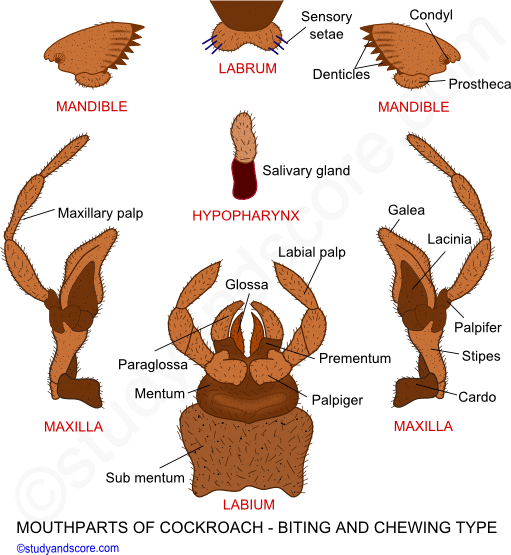
Mandibles: These are a pair of triangular, hard, unjointed, stout, chitinised structures. The mandibles are located on either side of mouth behind labrum. They are dentate along their inner margins and are masticatory in function. These mandibles are provided with two pairs of muscles namely, adductor and abductor muscles to help the movement of mandibles only in horizontal plane against each other.
First pair of maxillae: A pair of first maxillae is located behind mandibles on either side of the mouth. The first maxilla has two basal segments called cardo and stipes. Cardo is attached to the head capsule and stipes is attached to the cardo. The stipes has five segmented maxillary palp on its outer side. This palp is situated on a small sclerite called palpifer. Inner to the palp two chitinous lobes namely lacinea and galea are found attached to stipes. Lacinea is pincer like with two terminal denticles whereas galea is the outer soft hood life structure bearing long chitinous bristles. The maxillary palps are used for cleaning the antennae and also the front pair of legs.
Labium: Labium is formed by the fusion of second pair of maxillae. It is also known as lower lip. The basal segment of labium is called post-mentum. Labium includes two segments namely broad rectangular sub-mentum and a triangular mentum. Also pre-mentum is present in front of the mentum. Pre-mentum is formed by the fusion of two stipes and it bears a small sclerite called palpiger. Each palpiger has a 3-segmented labial palp. At the distal end the pre-mentum bears a pair of paraglossae inner to labial palps. A pair of glossae is present between paraglossae. The paraglossae and glossae together constitute ligula.
Hypopharynx: It is chitinous, grooved and a rod-like structure found hanging into the preoral cavity. It is also known as ligula or tongue. Hypopharynx divides the proximal part of preoral cavity into a larger anterior cibarium and a posterior salivarium. The salivary duct opens into salivarium at the base of the hypopharynx.
The mouthparts of housefly are of sponging type. Housefly feeds on any organic matter, exposed food or even an open wound and faecal matter. It takes liquid part of the material as food. Sugars containing solid foods are scrapped are liquefied with its saliva for sponging. The proboscis is divisible into rostrum, haustellum and labellum. Haustellum and labellum are modified labium. The following is the structure of each of the mouthpart,
Rostrum: It is the basal part of the proboscis and is proximally articulated with the head capsule. It is distally articulated with the haustellum by a hinge joint. The rostrum encloses pharynx and salivary duct. Pharynx communicated with the food canal. Mandibles are absent. First maxillae are represented by a pair of unjointed palps, which is present on the rostrum
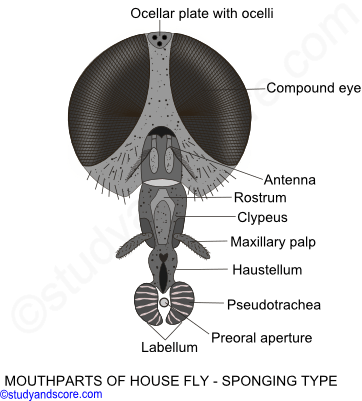
Haustellum: It is the middle part of the proboscis and the proximal part of labium. It bears a median groove on its dorsal side. In this groove, the hypopharynx containing the salivary canal and labrum epipharynx are present. They are closely pressed against each other and form a food canal. Haustellum bears a theca underneath it.
Labellum: This is the terminal part of the proboscis which is formed of two lobes called labella. A preoral opening is present between the two labella. Prestomial teeth are present on the undersurface of the labella. Labellum has sense organs of taste and smell. The labella bear many grooves supported by semicircular chitinous rings. They appear as tracheae and so they are also known as pseudotracheae. All pseudotracheae of both labella converge into the preoral opening.
When a housefly settles on the food, the haustellum and labella which are bent backwards underneath the rostrum are thrust out and labella are pressed against the food. Prestomial teeth break small food particles and some solid is dissolved in the saliva released on the food. This liquefied food enters pseudotracheae by the capillary action upto the mouth via food channel.
In the female horseflies which also possess sponging type of mouthparts, mandibles are present. The mandibles in these flies are useful in slicing the skin and then the blood which is exposed is sponged up.
The mouthparts of honeybee are chewing and lapping type. Also bumble-bees also have similar kind of mouth parts. Honey bees have a combined mouth parts than can both chew and suck. This is accomplished by having both mandibles and a proboscis.
Mandibles: The mandibles are a pair of jaws suspended from the head of the bee. The insect uses them to chew wood when redesigning the hive entrance, to chew pollen and to work wax for comb-building. They also permit any activity requiring a pair of grasping instruments. These paired "teeth" that can be opened and closed to get the work done.
Proboscis: The proboscis of the honeybee is not a permanent functional organ, but it is formed temporarily by assembling parts of the maxillae and the labium to produce a unique tube for drawing up liquids such as sweet juices, nectar, water and honey. The insect releases it when needed for use, then withdraws and folds it back beneath the head when it is not needed.
Labellum: The glossae are greatly elongated to form a hairy, flexible tongue. The glossa terminates into a small circular spoon shaped lobe called labellum, which is useful to lick the nectar. Labial palms are elongate and four segmented.
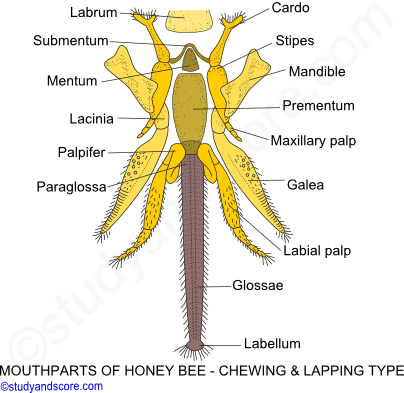
Maxillolabial Structures: Maxillolabial Structures are modified to form the lapping tongue. The tongue unit consists of the two galeae of maxillae, two labial Palps and an elongated flexible hairy glossa of labium.
The galeae fit tightly lengthwise, against the elongated labial palps and they in turn roof over the elongated glossae (tongue) to form a temporary food channel through which saliva is discharged. The tongue (glossae) is trusted into flower, which gets smeared with nectar. It is then retracted between labial palps & galeae. Nectar is then squeezed by galeae and is deposited in the cavity formed by the paraglossae. Accumulated nectar is then drawn into oesophagus by the pharyngeal pump.
Mouthparts of insects are modified cephalic appendages. Different insects have adapted themselves to different modes of ingestion of food. The basic structure of mouthparts remains the same. These similar mouthparts are an example of homologous organs. Homometabolous insects have different types of mouthparts in their larvae and adults. Hemimetabolous insects have similar type of mouthparts in their larvae and adults.
The mouthparts of female mosquito are piercing and sucking type. These types of mouth parts are present in almost all the bloodsucking insects like tse-tse fly, bed bug etc. Female mosquitoes feed on the blood of warm blood vertebrates. The mouthparts of mosquito are modified for piercing the skin of the vertebrates and then sucking their blood.
The mouthparts include labium, labrum-epipharynx, hypopharynx, mandibles and first maxillae. These mouthparts are characterized by stylets which are long and pointed. The number of stylets varies with different insects. Only maxillary stylets and mandibular stylets are present in bugs, whereas labrum-epipharynx and hypopharynx along with maxillary stylets and mandibular stylets are also present in mosquitoes. The following is the structure of each of the mouthpart,
Labium: It is a long, flesh, flexible and unpaired structure with groove called labial groove along its mid dorsal side. It is also called as proboscis. The labium bears a pair of lobes terminally called labella. The labella are interconnected by a membrane called as Dutton’s membrane. Labella represent the reduced labial palps. All the other mouthparts like mandibles, first pair of maxillae and hypopharynx are enclosed in the groove of the labium.
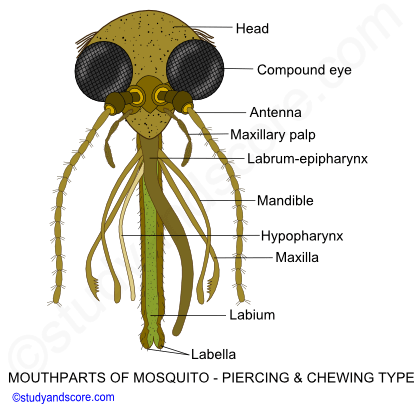
Labrum-epipharynx: This is a compound structure formed by the fusion of labrum and epipharynx. Labrum-epipharynx is a stylet that has a ventral groove, which forms the food canal with the hypopharynx.
Hypopharynx: It is a long flat stylet structure that forms the food canal with the labrum-epipharynx for sucking the blood. It also contains the salivary canal that injects saliva into the blood of the warm-blooded vertebrates.
Mandibles: Two mandibles are present each on either side. These are styles with blade like tips. They are useful to make a wound in the skin of the host. There are two first maxillae one on each side. These are the styles that bear serrated tips. Each maxilla bears a maxillary palp.
When a female mosquito sits on the host, it presses the proboscis against the skin. The flexible proboscis bends and the mandibles along with maxillae make a wound on the skin of the host. The labrum-epipharynx and hypopharynx are inserted into the wound. The serrated tips of maxillae keep the wound open. The sucking action of muscles of cibarium and pharyngeal muscles help in sucking the blood through the food canal. The saliva is injected into the blood through hypopharynx. This saliva of mosquito contains haemolysin which prevents the coagulation of blood. This bite of mosquito causes itching and mild inflammation. And the mosquito thus feeds on the blood of vertebrates.

- Share with your friends! -
Login to post your comment here...
- or with social Account -